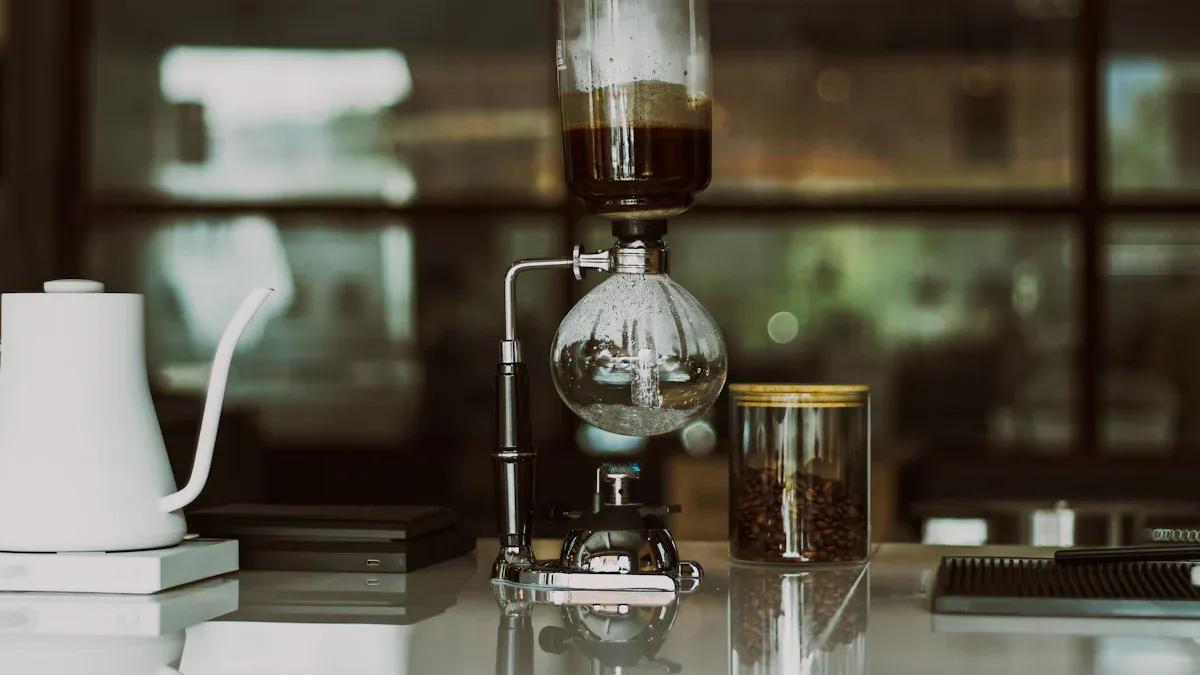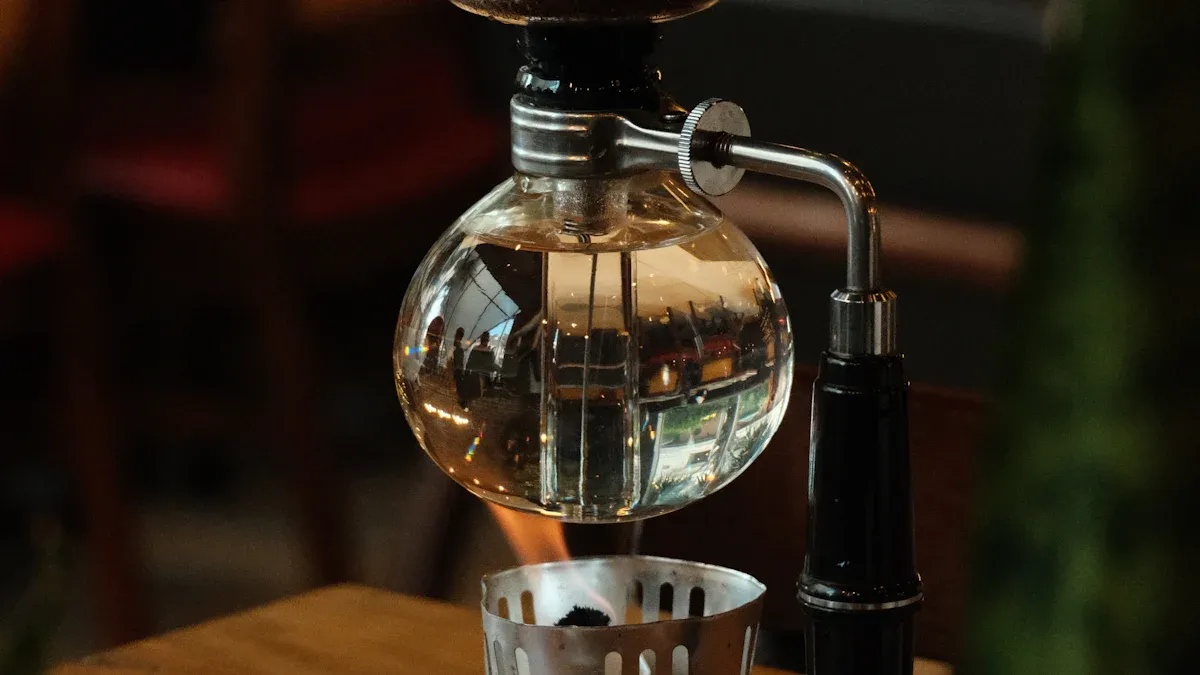
A coffee machine heating element allows you to heat water quickly and evenly, ensuring the water reaches the ideal temperature for brewing. This essential coffee machine heating body plays a crucial role in enhancing the flavor of your coffee by maintaining consistent heat. As one of the key coffee machine spare parts, the heating body is found inside every coffee maker and is vital for a great-tasting cup.
Key Takeaways
A coffee machine heating element warms water fast and keeps it hot for brewing. This is important for making coffee taste good.
Good heating elements are made from strong metals like nickel-chrome and stainless steel. They work with sensors to keep the water temperature steady between 195°F and 205°F.
When heating is steady and quick, your coffee tastes balanced and fresh every time. Bad heating can make coffee taste weak, bitter, or sour.
Coffee Machine Heating Element Basics
What Is a Heating Element
A heating element is inside your coffee maker. It changes electrical energy into heat. Every coffee machine has one. It is very important for making coffee. The heating element is near the water reservoir or inside a metal tube. Its main job is to heat water fast. It also keeps the water at the right temperature for brewing.
Tip: Always check that your coffee maker has water before you turn it on. If you run the heating element without water, it can get damaged.
You can look at the table below to see how different heating elements work and what they do:
Heating Element Type | Material & Construction Details | Working Principle & Role | Performance Characteristics & Importance |
|---|---|---|---|
Die-cast Boiler | Aluminum alloy or stainless steel, closed cavity | Stores and heats water to extraction temperature, stable supply | Rapid, even heating, corrosion resistant, precise temperature control |
Steam Boiler | Stainless steel or copper, built-in electric tube or steam coil | Heats water to boiling for steam generation | Fast heat conduction, stable steam, precise pressure control |
Aluminum Heating Tube | Aluminum shell, nickel-chromium wire, magnesium oxide insulation | Heats water flow rapidly by conduction | High thermal conductivity, lightweight, heats quickly |
Heating Plate | Stainless steel, aluminum, or ceramic with heating circuit | Directly heats water or coffee liquid | Fast, uniform heating, durable, precise temperature control |
Coffee Cup Heating Film | Graphene, carbon fiber, or metal foil on insulating substrate | Heats coffee cup walls to keep coffee warm | Instant heating, safe, uniform heat, auto power-off |
Coffee makers use heating elements made from nickel-chromium alloy or stainless steel. These materials do not rust and last a long time. The heating element has a filament, insulation, and a cover. Some coffee machines use triacs and thermostats. These help control the power and keep the temperature steady.
How It Works
The coffee machine heating element works because of electrical resistance. When you turn on your coffee maker, electricity goes through the heating element. The wire, usually made of nichrome, resists the electricity. This makes the wire hot. The heat moves to the water and warms it up fast.
This process is called the Joule heating effect. More resistance in the wire means more heat.
The heating element should always be under water. If not, it can get too hot and break.
Thermostats or thermistors watch the temperature. They turn the heating element on or off to keep the water just right.
Your coffee machine heating element should keep the water between 195°F and 205°F. This is the best temperature for making coffee. Staying in this range stops your coffee from tasting sour or bitter. For example:
Dark roast coffee tastes best at the lower end (195-198°F).
Light roast coffee needs higher temperatures (202-205°F) to taste good.
Espresso machines keep water around 201°F for a balanced flavor.
Note: Keeping the temperature steady is very important. Good heating elements keep the temperature within ±2°F. This helps you get the same great cup every time.
Coffee maker heating elements also work quickly. Many can heat one liter of water from 25°C to 95°C in less than three minutes. High-end coffee makers use better heating elements for even faster and steadier results. Where the heating element is placed and how good it is affects how well the water heats and how your coffee tastes.
Here is how the heating element works in the coffee maker:
The heating element heats the water.
The thermostat checks the temperature.
The controller turns the heating element on or off when needed.
Safety features like fuses stop overheating.
The coffee machine heating element is the most important part of your coffee maker. It gives you the heat you need for great coffee. When you know how it works, you can see why your coffee tastes so good.
Coffee Maker Heating Element Materials

Common Metals Used
A coffee maker heating element uses a few main metals. These metals are aluminum, copper, stainless steel, and nickel-chrome alloys. Each metal does something important. Aluminum makes the heating element light and heats up fast. Copper also heats quickly and does not rust easily. Stainless steel is strong and stops rust. Nickel-chrome alloys, like nichrome, make strong resistance. This resistance lets the heating element get hot when electricity passes through.
Tip: The best coffee pot heating element uses a good mix of these metals. This helps your coffee maker last longer and heat water evenly.
Structure and Design
A coffee maker heating element has several main parts. There are coils or filaments made from nickel-chrome wire. These coils are inside a tube, usually made of aluminum. The wire is set in plaster to keep it safe and strong. A layer of thermal grease sits between the heating element and the warming plate. This grease helps move heat better.
Here is a table that shows the main parts and what they do:
Component | Material/Description | Function |
|---|---|---|
Heating Element | Coiled aluminum or nichrome wire | Heats water and keeps coffee warm |
Aluminum Extrusion | Aluminum tube | Conducts heat and allows water flow |
Plaster Embedding | Plaster | Supports and protects the wire |
Heat-Conductive Grease | Thermal grease | Improves heat transfer |
Sensors | Temperature sensors | Prevents overheating |
Fuses | Electrical fuses | Cuts power if temperature gets too high |
Sensors like thermostats or thermistors are also used. These parts check the temperature and turn the heating element on or off. This keeps your coffee maker safe and your coffee at the right temperature.
Impact of Coffee Machine Heating Elements
Brewing Temperature and Extraction
Coffee machine heating elements help control water temperature. The right temperature is needed to get the best taste from coffee grounds. If water is too hot or too cold, coffee will not taste good.
A good heating element keeps water at a steady temperature. This is called stable extraction temperature. When you make coffee, the heating element works with sensors and switches. These parts help keep water hot during brewing. You do not want the water to cool down while brewing. If it does, coffee grounds will not give all their flavor.
Heating elements with sensors stop water from cooling down.
Some machines use smart controls to change the temperature. This helps you get the same taste every time.
Advanced systems use PID controllers. These change the heat in small steps. They also stop sudden changes in temperature.
In-line heating elements heat water fast and can change temperature quickly. You do not have to wait for a big boiler to heat up.
Multi-boiler systems have small boilers inside a big one. This keeps water moving and stops it from getting old.
Tip: If your coffee tastes weak or bitter, check if your machine keeps water hot enough. Steady temperature helps you get the most from your coffee grounds.
It is hard to measure water temperature exactly. The wires used to check temperature can change the reading. For example:
The size and type of wire can make the temperature look higher.
Wires that carry heat well can cause bigger mistakes.
How water moves around the sensor also changes the reading.
Smaller wires and good insulation help get better results.
Your coffee machine should keep water between 195°F and 205°F. This range helps you get the right flavor from coffee grounds. If the temperature drops, you get under-extraction. If it gets too high, you get over-extraction.
Effect on Coffee Flavor
Coffee machine heating elements do more than heat water. How your machine controls temperature changes the taste and smell of your coffee. When the heating element works well, you get a balanced cup every time.
Brewing at higher temperatures can make coffee taste bitter or sour. Lower temperatures can make coffee taste weak or too acidic. For espresso, hotter water brings out stronger flavors. If you brew at a lower temperature, you may not get all the flavor from your coffee grounds.
Keeping the temperature steady helps avoid sudden taste changes.
If the heating element heats up fast, you wait less for coffee. This keeps coffee fresh and makes it taste better.
Some machines lower the water temperature at the end of brewing. This helps stop bitterness in your cup.
For milk drinks, a strong heating element makes better steam. This gives creamy froth and improves taste and texture.
Note: If your coffee tastes different each time, your machine may not keep the temperature steady. Consistent heating helps you get the same flavor and aroma every day.
You can see how temperature, extraction, and flavor are linked in the table below:
Brewing Temperature | Extraction Result | Flavor and Aroma Impact |
|---|---|---|
Too Low (<195°F) | Under-extraction | Weak, sour, not enough aroma |
Ideal (195–205°F) | Balanced extraction | Full flavor, rich aroma, sweet, smooth |
Too High (>205°F) | Over-extraction | Bitter, harsh, burnt taste |
Better heating in your coffee machine gives you better results. Fast and steady heating means you get coffee quicker and with better taste. The impact of coffee machine heating elements shows in every cup. When you know how these parts work, you can pick a machine that gives you the flavor you want.
You need the heating element to make good coffee each day. New materials and smart controls help your machine heat water fast. They also keep the water at the best temperature. If you know how this part works, you can pick a coffee maker that lasts longer. You will also get better-tasting coffee every time.
Remember: A good heating element gives you better coffee at home, in cafes, or at work. ☕
FAQ
How do you know if your coffee machine heating element is broken?
If your coffee does not get hot or the machine takes too long to brew, the heating element may have failed. You should check for visible damage.
Can you replace a coffee machine heating element yourself?
You can replace it if you have basic tools and follow the manual. If you feel unsure, ask a professional for help.
Why does your coffee taste weak even when you use enough grounds?
The water may not reach the right temperature.
The heating element may not work well.
Check your machine’s temperature settings.


